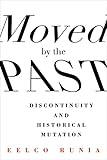Moved by the Past : Discontinuity and Historical Mutation / Eelco Runia.
Material type: TextSeries: European Perspectives: A Series in Social Thought and Cultural CriticismPublisher: New York, NY : Columbia University Press, [2014]Copyright date: ©2014Description: 1 online resource (264 p.) : 0Content type:
TextSeries: European Perspectives: A Series in Social Thought and Cultural CriticismPublisher: New York, NY : Columbia University Press, [2014]Copyright date: ©2014Description: 1 online resource (264 p.) : 0Content type: - 9780231168205
- 9780231537575
- 901 23
- D16.8 .R895 2014
- PT5881.28.U43
- online - DeGruyter
- Issued also in print.
| Item type | Current library | Call number | URL | Status | Notes | Barcode | |
|---|---|---|---|---|---|---|---|
 eBook
eBook
|
Biblioteca "Angelicum" Pont. Univ. S.Tommaso d'Aquino Nuvola online | online - DeGruyter (Browse shelf(Opens below)) | Online access | Not for loan (Accesso limitato) | Accesso per gli utenti autorizzati / Access for authorized users | (dgr)9780231537575 |
Frontmatter -- Contents -- Introduction -- 1. Burying the Dead, Creating the Past -- 2. "Forget about it" -- 3. Presence -- 4. Spots of time -- 5. Thirsting for Deeds -- 6. Into Cleanness leaping -- 7. Inventing the new from the old -- 8. Crossing the Wires in the Pleasure machine -- 9. Our own best Enemy -- Coda -- Notes -- Index -- Backmatter
restricted access online access with authorization star
http://purl.org/coar/access_right/c_16ec
Historians go to great lengths to avoid confronting discontinuity, searching for explanations as to why such events as the fall of the Berlin Wall, George W. Bush's invasion of Iraq, and the introduction of the euro logically develop from what came before. Moved by the Past radically breaks with this tradition of predating the past, incites us to fully acknowledge the discontinuous nature of discontinuities, and proposes to use the fact that history is propelled by unforeseeable leaps and bounds as a starting point for a truly evolutionary conception of history. Integrating research from a variety of disciplines, Eelco Runia identifies two modes of being "moved by the past": regressive and revolutionary. In the regressive mode, the past may either overwhelm us-as in nostalgia-or provoke us to act out what we believe to be solidly dead. When we are moved by the past in a revolutionary sense, we may be said to embody history: we burn our bridges behind us and create accomplished facts we have no choice but to live up to. In the final thesis of Moved by the Past, humans energize their own evolution by habitually creating situations ("catastrophes" or sublime historical events) that put a premium on mutations. This book therefore illuminates how every now and then we chase ourselves away from what we were and force ourselves to become what we are. Proposing a simple yet radical change in perspective, Runia profoundly reorients how we think and theorize about history.
Issued also in print.
Mode of access: Internet via World Wide Web.
In English.
Description based on online resource; title from PDF title page (publisher's Web site, viewed 02. Mrz 2022)


